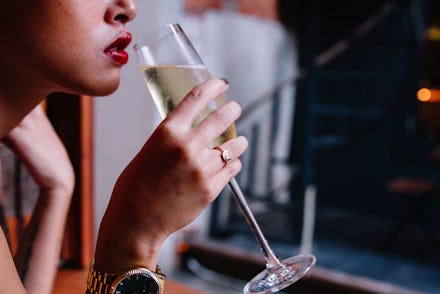Japan's standing bars speak to our desire to drink alone, together

Back when I had an office job, happy hour seemed like the perfect way to decompress from the workweek slog. I loved my co-workers, but as an introvert, the last thing I wanted was to fill my Friday night with even more face time with them. And because my job required me to constantly be “on” and social, prepared to engage in witty banter and small talk at any moment, I wasn’t exactly eager to rally my friends to grab a drink with me, either. The Japanese, on the other hand, seem to have mastered the art of imbibing alone in public. On a recent trip to Kyoto, I discovered the perfect venue for people like me: tachinomiya, bars where it seems common to unwind solo.
Tachinomiya, typically translated as "standing bars," according to the Japan Times, are exactly what they sound like: bars that contain tables, but no chairs. Their roots stretch back to the Edo Period, per the Times, which spanned from 1603 to 1868. At the time, sake shops began serving pours in wooden measuring cups, or masu. During the Meiji Era, from 1868 to 1912, these evolved into stores that sold wine, beer, and spirits, and housed counters made from wood propped up with beer crates.
Often tucked in narrow alleys, tachinomiya were traditionally unpretentious establishments near working-class neighborhoods or train stations where folks could grab a drink on their way home from the office, per Japanese restaurant guide Gurunavi. Their ambiance often reflects these humble origins; the tachinomiya I visited in downtown Kyoto had handwritten menus and tended not to bother with trendy décor or even music. One played soft jazz, but otherwise, the background noise consisted of the low hum of conversation and local variety shows playing on a TV mounted on the wall, not the pulsing, deafening music and yell-talking hybrid you often hear in American bars.
While these bars are a little more scene-y now, Tochinomiya menus typically stick to the classics: beer, sake, shochu (a spirit distilled from barley, rice, or sweet potato), and simple cocktails, like whisky highballs, plus small bites, each for less than $10. But don’t confuse classic with bland. The first standing bar my partner and I visited — Tachinomi Kokoro, a sports bar he found on a website called Sharing Kyoto — served the best sashimi tartare I’ve ever eaten: rich, fatty chunks of salmon and tuna, topped with creamy raw egg yolk and scallions, for only around three bucks.
We dipped inside in the afternoon, though, when there were only a handful of other customers, and planned to visit more tachinomiya the following night, a Friday, for a livelier vibe — whatever that meant for a place where people tend to drink alone.
I kept thinking, if only places like this existed back home in the States: casual spots where people can enjoy a drink by themselves among others, but not necessarily in their company, unencumbered by self-consciousness.
Our first standing bar stop after a long, humid Friday spent hiking and wending through throngs of tourists was a tiny spot called Momiji. It attracted a middle-aged clientele, most of whom seemed to have trickled in after work, still in crisp business attire. I loved that the atmosphere had a peaceful quality, despite the crowd. At least half the patrons were relaxing by themselves over a drink and a small bite — and looked perfectly content doing so. I kept thinking, if only places like this existed back home in the States: casual spots where people can enjoy a drink by themselves among others, but not necessarily in their company, unencumbered by self-consciousness.
The next spot we visited, Masuya Saketen — whose long, communal wooden tables, and exposed ceiling seemed to attract a younger crowd — was my favorite. The place was packed, though, so we waited several minutes for a server. We stood next to a guy who looked like he was in his 20s, wearing slacks and a button-up shirt with the sleeves rolled up, a slow dissipating intensity in his expression that led us to think this was an after-a-long-day drink.
He’d come alone, and it wasn’t weird. In fact, he chatted us up, and ended up ordering us pours of his two favorite sakes. Through broken Japanese and English, combined with Google Translate, we learned that he worked for Japan’s largest cell phone provider, and that although tachinomiya can be found throughout Japan, they’re particularly popular in Kyoto. He typically visited Masuya Saketen three nights a week after work. “Do you come here with coworkers?” my partner typed into his phone, then flashed the Google translation to him.
He shook his head and laughed. “No. By myself.”
I’ve often read that Japan is a nation of introverts, and indeed, I often saw people comfortably alone in other contexts too, like grabbing dinner in a restaurant. So the fact that enjoying a drink at a bar, alone, doesn’t carry quite the same stigma here as it does in the US makes sense. As an introvert who needs her solitude, but dreads library silence, I get it, and wish I could enjoy an equivalent stateside.